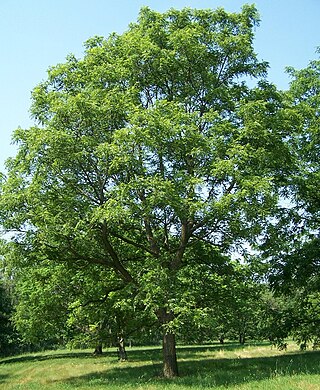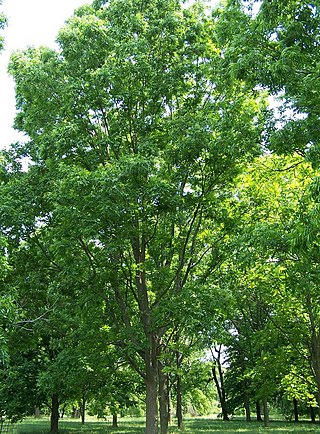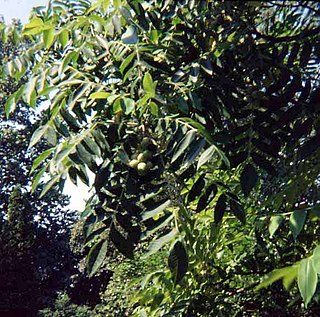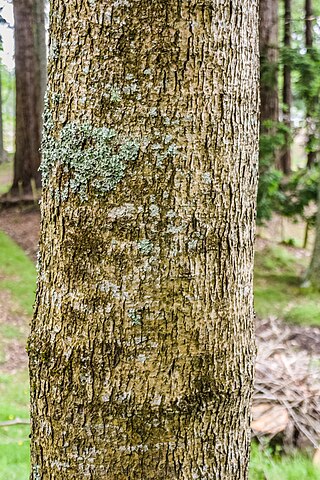
In botany, a drupe is an indehiscent fruit in which an outer fleshy part surrounds a single shell of hardened endocarp with a seed (kernel) inside. These fruits usually develop from a single carpel, and mostly from flowers with superior ovaries.

Walnut trees are any species of tree in the plant genus Juglans, the type genus of the family Juglandaceae, the seeds of which are referred to as walnuts. All species are deciduous trees, 10–40 metres (33–131 ft) tall, with pinnate leaves 200–900 millimetres (7.9–35.4 in), with 5–25 leaflets; the shoots have chambered pith, a character shared with the wingnuts (Pterocarya), but not the hickories (Carya) in the same family.

The pecan is a species of hickory native to the southern United States and northern Mexico in the region of the Mississippi River. The tree is cultivated for its seed in the southern United States, primarily in Georgia, New Mexico, Texas, and Mexico, which produces nearly half of the world total. The seed is an edible nut used as a snack and in various recipes, such as praline candy and pecan pie. The pecan is the state nut of Alabama, Arkansas, California, and Texas and is also the state tree of Texas.

Hickory is a common name for trees composing the genus Carya, which includes around 18 species. Five or six species are native to China, Indochina, and India (Assam), as many as twelve are native to the United States, four are found in Mexico, and two to four are native to Canada. A number of hickory species are used for products like edible nuts or wood.

Juglans nigra, the eastern American black walnut, is a species of deciduous tree in the walnut family, Juglandaceae, native to North America. It grows mostly in riparian zones, from southern Ontario, west to southeast South Dakota, south to Georgia, northern Florida and southwest to central Texas. Wild trees in the upper Ottawa Valley may be an isolated native population or may have derived from planted trees.

Juglans cinerea, commonly known as butternut or white walnut, is a species of walnut native to the eastern United States and southeast Canada.

Juglans regia, the Persian walnut, English walnut, Carpathian walnut, Madeira walnut, or especially in Great Britain, common walnut, is an Old World walnut tree species native to the region stretching from the Balkans eastward to the Himalayas and southwest China. It is widely cultivated across Europe.

Juglans ailantifolia, the Japanese walnut, is a species of walnut native to Japan and Sakhalin. It is a deciduous tree growing to 20 m (66 ft) tall, rarely 30 m (98 ft), and 40–80 cm stem diameter, with light grey bark. The leaves are pinnate, 50–90 cm long, with 11-17 leaflets, each leaflet 7–16 cm long and 3–5 cm broad. The whole leaf is downy-pubescent, and a somewhat brighter, yellower green than many other tree leaves. The male flowers are inconspicuous yellow-green catkins produced in spring at the same time as the new leaves appear. The female flowers have pink/ red pistils. The fruit is a nut, produced in bunches of 4-10 together; the nut is spherical, 3–5 cm long and broad, surrounded by a green husk before maturity in mid autumn.

Spondias purpura is a species of flowering plant in the cashew family, Anacardiaceae, that is native to tropical regions of the Americas, from Mexico to Brazil. It is also very common in most of the Caribbean islands. It is commonly known as jocote, which derives from the Nahuatl word xocotl, meaning any kind of sour or acidic fruit. Other common names include red mombin, plum, purple mombin, hog plum, ciriguela, ceriguela, seriguela, siriguela (Brazil) cocota, ciruela huesito (Colombia), ciruela, ciruela traqueadora (Panama), ciriguela, cirigüela, cirguela, cirguelo (Ecuador), makapruim, and siniguelas (Philippines). It is a popular fruit throughout Central America, particularly in El Salvador, Nicaragua, Honduras and in Costa Rica.

Juglone, also called 5-hydroxy-1,4-naphthalenedione (IUPAC) is an organic compound with the molecular formula C10H6O3. In the food industry, juglone is also known as C.I. Natural Brown 7 and C.I. 75500. It is insoluble in benzene but soluble in dioxane, from which it crystallizes as yellow needles. It is an isomer of lawsone, which is the staining compound in the henna leaf.

Juglans australis, the nogal criollo, is a species of plant in the Juglandaceae family. This large, fast-growing tree can grow to 20 m (66 ft) tall at elevations of 0.5—1.5 km in the Southern Andean Yungas, montane cloud forests on the eastern slopes of the Andes in Tucumán, Salta, and Jujuy provinces of Argentina and Tarija and Chuquisaca departments of Bolivia. It is threatened by habitat loss.
Juglans jamaicensis, the West Indian walnut, nogal, or palo de nuez, is a species of walnut in the Juglandaceae family. It is found in Cuba, [[Hispaniola, and Puerto Rico. It is not, in fact, native to Jamaica, as its name would suggest.

Juglans olanchana is a semideciduous tree species in the Juglandaceae family. It can be found in Costa Rica, Guatemala, El Salvador, Honduras, Mexico and Nicaragua. It can grow up to 40 m in height and 1.5 m in diameter. The long branches bear twigs tipped with 40–50 cm long, glabrous, pinately compound leaves, darker on the top than on the bottom. The base of the trunk sometimes has buttresses.

Juglans hindsii, commonly called the Northern California black walnut and Hinds's black walnut, is a species of walnut tree native to the western United States. It is commonly called claro walnut by the lumber industry and woodworkers, and is the subject of some confusion over its being the root stock for English walnut orchard stock.
Rhagoletis juglandis, also known as the walnut husk fly, is a species of tephritid or fruit fly in the family Tephritidae. It is closely related to the walnut husk maggot Rhagoletis suavis. This species of fly belongs to the R. suavis group, which has a natural history consistent with allopatric speciation. The flies belonging to this group are morphologically distinguishable.
Juglans venezuelensis, or nogal de Caracas, is a species of black walnut endemic to Venezuela. It is a small tree which bears 1 inch nuts.

A walnut is the edible seed of any tree of the genus Juglans, particularly the Persian or English walnut, Juglans regia. The fruits of trees in the are often confused with drupes. Still, they are accessory fruit because the outer covering of the fruit is technically an involucre and thus not morphologically part of the carpel; this means it cannot be a drupe but is instead a drupe-like nut.

Phytelephas macrocarpa is a single-stemmed, unarmed, reclining or erect palm from the extreme northern coastal regions of South America, growing to some 12 m tall. It has been introduced and cultivated in tropical regions all over the world. The trunk is about 30 cm across, with prominent leaf scars. The crown is made up of about 30 plume-like leaves or fronds, each about 8 m long, dead leaves being persistent. It is one of some 7 species of palm in the genus Phytelephas, all of which have been exploited for vegetable ivory or tagua from the seed or corozo nut. The closely related Ammandra decasperma from Colombia, and Aphandra natalia from Ecuador, are also sources of vegetable ivory, but of inferior quality and therefore not commercially significant. 'Phytelephas macrocarpa' translates to ‘elephant plant’ with 'large fruit', the endosperm of the nut having the texture of elephant ivory, and consisting of large, thick-walled cells of two long-chain polysaccharides, mannan A and B.

Areca nut production in India is dominant in the coastal region within 400 kilometres (250 mi) from the coast line, and also in some other non-coastal states of India. Areca nut, a tropical crop, is popularly known as betel nut, as its common usage in the country is for mastication with betel leaves. It is a palm tree species under the family of Arecaceae. It has commercial and economic importance not only in India but also in China and Southeast Asia.

The Northwestern Andean montane forests (NT0145) is an ecoregion on the Andes mountains in the west of Colombia and Ecuador. Both flora and fauna are highly diverse due to effect of ice ages when the warmer climate zones were separated and the cooler ones combined, and interglacial periods when the reverse occurred. Because the environment is hospitable to humans, the habitat has been drastically modified by farming and grazing since the Pre-Columbian era.



















